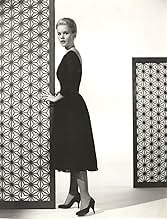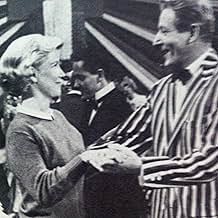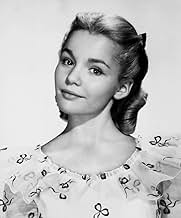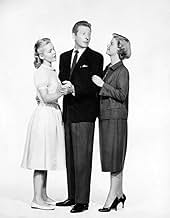IMDb RATING
7.1/10
2.2K
YOUR RATING
Danny Kaye cuts loose with his trademark musical clowning. Louis "Satchmo" Armstrong plays his horn and croons in that famed gargling-granite voice. Big Band icons Bob Crosby, Ray Anthony an... Read allDanny Kaye cuts loose with his trademark musical clowning. Louis "Satchmo" Armstrong plays his horn and croons in that famed gargling-granite voice. Big Band icons Bob Crosby, Ray Anthony and Shelly Manne join the fun.Danny Kaye cuts loose with his trademark musical clowning. Louis "Satchmo" Armstrong plays his horn and croons in that famed gargling-granite voice. Big Band icons Bob Crosby, Ray Anthony and Shelly Manne join the fun.
- Nominated for 4 Oscars
- 2 wins & 8 nominations total
Eric Alden
- Musician
- (uncredited)
Babette Bain
- Rehabilitation Patient
- (uncredited)
Bill Baldwin
- Announcer
- (uncredited)
Sheryn Banks
- Girl at Birthday Party
- (uncredited)
Earl Barton
- Choreographer
- (uncredited)
Henry Beau
- Undetermined Secondary Role
- (uncredited)
Featured reviews
This is an odd one.
I look back on 'The Five Pennies' in two parts. The first half of the film is uninteresting and slow, but once the story gets set and the second half comes to fruition it turns into something rather touching - which I didn't expect at all. By the end, I felt truly attached to the characters and their story - but that's weird, given how I didn't enjoy the early stages.
Danny Kaye is very good in the lead role of Red, especially towards the end. Susan Gordon (Dorothy, as a kid) impressed me a bunch, she has one fantastic poker scene with Kaye. Barbara Bel Geddes, meanwhile, plays the role of Willa well.
The film, a loose biopic on the real Red Nichols, is music-heavy. Early on I think that affects things from a film point of view, but you can at least tell the cast - particularly Kaye and Louis Armstrong (as himself) - are having a fun time.
Overall, I think it's lovely - but I can't recall a film that's split my feelings from start-to-finish as much as this did.
I look back on 'The Five Pennies' in two parts. The first half of the film is uninteresting and slow, but once the story gets set and the second half comes to fruition it turns into something rather touching - which I didn't expect at all. By the end, I felt truly attached to the characters and their story - but that's weird, given how I didn't enjoy the early stages.
Danny Kaye is very good in the lead role of Red, especially towards the end. Susan Gordon (Dorothy, as a kid) impressed me a bunch, she has one fantastic poker scene with Kaye. Barbara Bel Geddes, meanwhile, plays the role of Willa well.
The film, a loose biopic on the real Red Nichols, is music-heavy. Early on I think that affects things from a film point of view, but you can at least tell the cast - particularly Kaye and Louis Armstrong (as himself) - are having a fun time.
Overall, I think it's lovely - but I can't recall a film that's split my feelings from start-to-finish as much as this did.
10neal-57
This little gem can be appreciated on two levels. Non-jazz fans who have never heard of Red Nichols will find a fine little "family movie," which despite its 192O's-speakeasy milieu offers up nothing seamier than the observation by Red's wife, Bobbi (Barbara Bel Geddes in a performance of remarkable warmth) that their daughter has come to believe that "breakfast is a cup of coffee and an aspirin." The story of the daughter's attack of polio and her fight to walk again is unflinching and the first-time viewer should pack sufficient Kleenex. Fans of Danny Kaye will find plenty of examples of his trademark clowning, but they'll also find moments of wonderful dramatic and introspective acting.
The most remarkable scene in the movie: a guilty Nichols/Kaye, feeling that his daughter's polio is the direct result of his neglect of her in favor of jazz, promises God that if she survives, he will give up music and devote himself to her care. Sound hokey? Could have been. But the scene where Kaye throws his cornet into the river is absolutely spine-chilling. He stops, tenderly caressing the cornet keys, allowing the happy memories to pass wistfully over his features...then coldly, abruptly, tosses the instrument into the waters below. When Kaye straightens up, he seems to have aged twenty years and gained fifty pounds...a remarkable scene.
The second level on which the film can be appreciated: an introduction to a wonderful musician. Like "The Glenn Miller Story" and "The Benny Goodman Story," "The Five Pennies" makes little attempt to give an accurate portrayal of its subject. Ernest Loring Nichols, from all accounts, was a cool, calculating businessman, nothing like the madcap, freewheeling character played by Danny Kaye. As a cornetist he stood willingly in the shadow of his idol Bix Beiderbecke, whose playing style he strove (with some success) to duplicate. Despite the fact that Bix was the major personal and professional influence on Red, he is mentioned only once, toward the end of the film: "(in those early days) there was Louis (Armstrong), Bix and me--and that was it!"
Biographical inaccuracies aside, the pure tone of the real Nichols' cornet shines through brilliantly, and reaches out to grab the ear of the traditional jazz fan--at least it did mine. When I first saw the film in '81, I was a Glenn Miller and Benny Goodman fan, and knew Nichols only as a bandleader they had played with early on. The movie was a springboard, leading me to search out the albums, and the real biographical details, of the very real Red Nichols.
Incidentally, the film benefited the by-then largely forgotten Nichols greatly: just as the late-5O's dixieland-revival was gathering steam, he landed a Columbia contract, and recorded some wonderful stereo albums of his past hits--and of the music specially written for the film by Silvia Fine (Mrs. Danny Kaye). Though he died in '65 (while in Vegas to play a gig), his music lives on through these wonderful albums --and through the soundtrack on Decca, featuring not only Nichols but Louis Armstrong. Their duets, through placed in fictionalized scenes, stand as a legitimate audio document of two of the earliest and most influential cornetist/trumpeters in history playing together--in glorious, analog stereo. I'll join the others who've commented on this film in wishing that this wonderful soundtrack would be released on CD. (Not outside the realm of possibility: the soundtrack of "Pete Kelly's Blues, from the same time period, has just appeared on CD...so who knows?)
For both traditional jazz fans, and those who appreciate wholesomely uplifting (but NOT goody-goody) film, this movie is a treasure.
The most remarkable scene in the movie: a guilty Nichols/Kaye, feeling that his daughter's polio is the direct result of his neglect of her in favor of jazz, promises God that if she survives, he will give up music and devote himself to her care. Sound hokey? Could have been. But the scene where Kaye throws his cornet into the river is absolutely spine-chilling. He stops, tenderly caressing the cornet keys, allowing the happy memories to pass wistfully over his features...then coldly, abruptly, tosses the instrument into the waters below. When Kaye straightens up, he seems to have aged twenty years and gained fifty pounds...a remarkable scene.
The second level on which the film can be appreciated: an introduction to a wonderful musician. Like "The Glenn Miller Story" and "The Benny Goodman Story," "The Five Pennies" makes little attempt to give an accurate portrayal of its subject. Ernest Loring Nichols, from all accounts, was a cool, calculating businessman, nothing like the madcap, freewheeling character played by Danny Kaye. As a cornetist he stood willingly in the shadow of his idol Bix Beiderbecke, whose playing style he strove (with some success) to duplicate. Despite the fact that Bix was the major personal and professional influence on Red, he is mentioned only once, toward the end of the film: "(in those early days) there was Louis (Armstrong), Bix and me--and that was it!"
Biographical inaccuracies aside, the pure tone of the real Nichols' cornet shines through brilliantly, and reaches out to grab the ear of the traditional jazz fan--at least it did mine. When I first saw the film in '81, I was a Glenn Miller and Benny Goodman fan, and knew Nichols only as a bandleader they had played with early on. The movie was a springboard, leading me to search out the albums, and the real biographical details, of the very real Red Nichols.
Incidentally, the film benefited the by-then largely forgotten Nichols greatly: just as the late-5O's dixieland-revival was gathering steam, he landed a Columbia contract, and recorded some wonderful stereo albums of his past hits--and of the music specially written for the film by Silvia Fine (Mrs. Danny Kaye). Though he died in '65 (while in Vegas to play a gig), his music lives on through these wonderful albums --and through the soundtrack on Decca, featuring not only Nichols but Louis Armstrong. Their duets, through placed in fictionalized scenes, stand as a legitimate audio document of two of the earliest and most influential cornetist/trumpeters in history playing together--in glorious, analog stereo. I'll join the others who've commented on this film in wishing that this wonderful soundtrack would be released on CD. (Not outside the realm of possibility: the soundtrack of "Pete Kelly's Blues, from the same time period, has just appeared on CD...so who knows?)
For both traditional jazz fans, and those who appreciate wholesomely uplifting (but NOT goody-goody) film, this movie is a treasure.
... but I could never see the movie yet. Still, it partly saved my life when I was dying of a very bad pneumonia and was floating in between the two worlds. I didn't yet understand English, but the soundtrack of The Five Pennies played on the vinyl record (don't ask me how my Finnish parents got to possess it) went through my conscience and kept me on the living side. I can still sing one voice of the lullaby hearing Danny Kaye and Louis Armstrong singing the other voices in my head. I'm lucky to be able to hear them without any technical device.
Now, by a coincidence I fall on this movie I never saw - so important in my life - on VHS / NTSC in Amazon. I live in Europe... No way being able to see it. Do you really mean that there's no DVD of it yet ? I seem to be not the only one wishing for it.
Now, by a coincidence I fall on this movie I never saw - so important in my life - on VHS / NTSC in Amazon. I live in Europe... No way being able to see it. Do you really mean that there's no DVD of it yet ? I seem to be not the only one wishing for it.
10sdhalfon
my favorite bit of this film is at the end, I care not how factual it is. I find a lump in my throat every single time I see it and I am usually blubbing like a baby by the end credits. It is a wonderful story of a very talented man and of a great time in musical history, the scenes with 'Satchmo' Louis Armstrong are another particular favorite as he usually steals the scene. The little girl actress put s in a fine and mature performance as 'Red' Nicols's daughter. But as usual Danny Kaye is nothing short of majestic he is perfectly at home miming to Lorne 'Red' Nicols cornet playing. The story is beautiful as is the acting. Don't forget to pack your Kleenex when you watch it though. Excellent family entertainment twenty out of ten......
Sentimental biography of a famous jazzman , Red Nichols, stars Danny Kaye paying tribute to this great musician by providing a terrific acting and whose traumatic private life was a little shocking for Hollywood standards . Along the way , there appears Louis "Satchmo" Armstrong who plays his horn and croons in that famed gargling-granite voice. Other famous horn players and Big Band icons as Bob Crosby, Ray Anthony and Shelly Manne join the fun.
The plot is plain and simple , an engaging biographic chronicle , featuring perormances from legendary musicians as Bob Crosby, , Bobby Troup , Ray Anthony , Luis Armstrong and Red Nichols magnificently played by Danny Kaye who cuts loose with his trademark musical clowning . The film is a Danny Kaye recital , he plays his horn , sings ,and puts some faces and grimaces . Sylvia Fine , Kaye's wife , is the lyricist , composer , besides associate producer and dialogs writer , and responsible for many of the best known musical routines and songs for her husband . This is a mirth as well as melancholic rhapsody in which the duo starring : Danny Kaye as the extraordinary jazzman and Barbara Bel Geddes as the woman who he loved , both of whom giving awesome performance . An engaging and charming film , though tends to be overlong and slow-moving at times , concerning a dramatic portrayal of a horn player who fights to fill his need for music , while becomes trapped in some dramatic misfortunes . Accompanying them a lot of wonderful of secondary actors and musicians , such as : Harry Guardino , Bob Crosby, Bobby Troup , Susan Gordon , Ray Anthony, Shelly Manne and a teen Tuesday Weld. What the script lacks in originality is amply made up for the extraordinary music and outstanding cast . Highlights the moving musical score by composer Leith Stevens and colorful cinematography by Daniel L. Fapp , while enjoyable apperance by Louis Armstrong make it a must-see for Jazz enthusiasts .
This musical drama was competently made by one of the best Golden Hollywood directors , Melville Shavelson. His movies have a special penchant for recapturing a particular atmosphere , many of this movies are about real people but they remain muted in impact . A notorious screenwriter , Bob Hope and Danny Kaye features Shavelson's movies when he became filmmaker and his films with them are the most successful such as : ¨The seven tittle Foys¨ , Beau James¨, ¨On the Double¨ and ¨Five pennies¨ . Shavelson's later pictures were made for TV and mostly biographies as ¨The great Houdini¨ , ¨Ike¨, ¨Ike : the war years¨, and ¨The legend of Valentino¨ which remains the best work on the subject to date . Two of the best films resulted to be ¨¨Cast a giant shadow¨ , an epic movie with all-star-cast dealing with the birth of Israel and one of his biggest hits was ¨Yours , mine and ours¨. The Five Pennies (1959) rating : 7/10 . Better than average. The flick will appeal to Jazz lovers and Danny Kaye, Louis Armstrong fans.
The plot is plain and simple , an engaging biographic chronicle , featuring perormances from legendary musicians as Bob Crosby, , Bobby Troup , Ray Anthony , Luis Armstrong and Red Nichols magnificently played by Danny Kaye who cuts loose with his trademark musical clowning . The film is a Danny Kaye recital , he plays his horn , sings ,and puts some faces and grimaces . Sylvia Fine , Kaye's wife , is the lyricist , composer , besides associate producer and dialogs writer , and responsible for many of the best known musical routines and songs for her husband . This is a mirth as well as melancholic rhapsody in which the duo starring : Danny Kaye as the extraordinary jazzman and Barbara Bel Geddes as the woman who he loved , both of whom giving awesome performance . An engaging and charming film , though tends to be overlong and slow-moving at times , concerning a dramatic portrayal of a horn player who fights to fill his need for music , while becomes trapped in some dramatic misfortunes . Accompanying them a lot of wonderful of secondary actors and musicians , such as : Harry Guardino , Bob Crosby, Bobby Troup , Susan Gordon , Ray Anthony, Shelly Manne and a teen Tuesday Weld. What the script lacks in originality is amply made up for the extraordinary music and outstanding cast . Highlights the moving musical score by composer Leith Stevens and colorful cinematography by Daniel L. Fapp , while enjoyable apperance by Louis Armstrong make it a must-see for Jazz enthusiasts .
This musical drama was competently made by one of the best Golden Hollywood directors , Melville Shavelson. His movies have a special penchant for recapturing a particular atmosphere , many of this movies are about real people but they remain muted in impact . A notorious screenwriter , Bob Hope and Danny Kaye features Shavelson's movies when he became filmmaker and his films with them are the most successful such as : ¨The seven tittle Foys¨ , Beau James¨, ¨On the Double¨ and ¨Five pennies¨ . Shavelson's later pictures were made for TV and mostly biographies as ¨The great Houdini¨ , ¨Ike¨, ¨Ike : the war years¨, and ¨The legend of Valentino¨ which remains the best work on the subject to date . Two of the best films resulted to be ¨¨Cast a giant shadow¨ , an epic movie with all-star-cast dealing with the birth of Israel and one of his biggest hits was ¨Yours , mine and ours¨. The Five Pennies (1959) rating : 7/10 . Better than average. The flick will appeal to Jazz lovers and Danny Kaye, Louis Armstrong fans.
Did you know
- TriviaWhile Danny Kaye worked hard to be able to accurately fake playing cornet (he practiced for months learning the fingering of the instrument), it was the real Red Nichols who provided all of the cornet playing for Kaye in this movie.
- GoofsAfter Red and Willa have left the club and are traveling home, the cars seen through the rear window of the taxicab are distinctly 1940's to 1950's vehicles which were nonexistent in 1924.
- Quotes
Louis Armstrong: Excuse it, folks. Somebody must have put alcohol in our liquor.
- ConnectionsFeatured in American Masters: Danny Kaye: A Legacy of Laughter (1996)
- SoundtracksThe Five Pennies
(1959)
Words and Music by Sylvia Fine
Sung by Danny Kaye (uncredited) to Dorothy
Performed by Eileen Wilson (uncredited) at the comeback show
- How long is The Five Pennies?Powered by Alexa
Details
- Runtime1 hour 57 minutes
- Aspect ratio
- 1.85 : 1
Contribute to this page
Suggest an edit or add missing content

Top Gap
By what name was Millionnaire de cinq sous (1959) officially released in India in English?
Answer

































